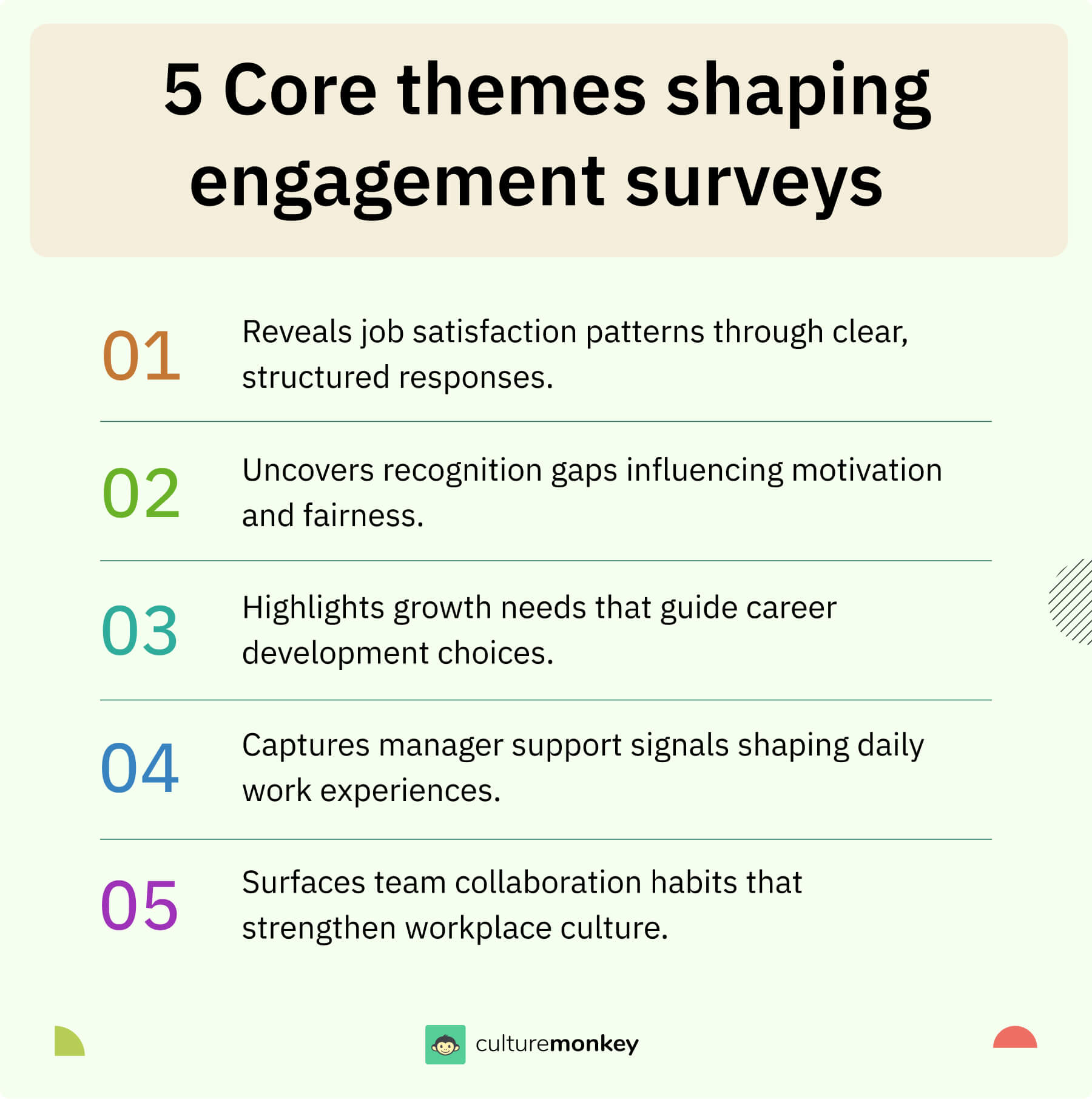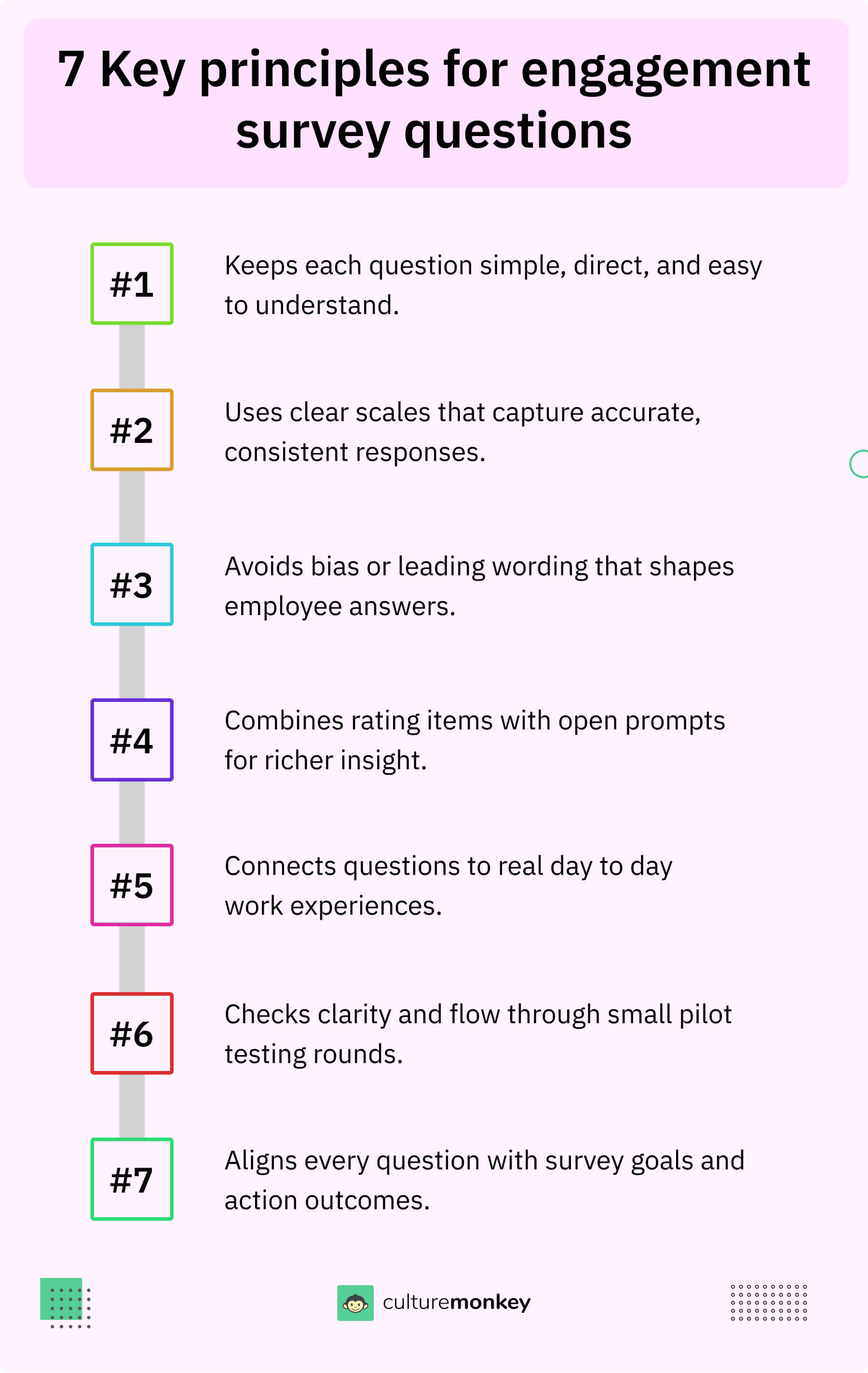50+ Ready-to-use employee engagement questionnaire to sustain workplace engagement in 2026

Remember planting seeds as a kid and checking every day to see if they’d sprouted? You’d water them, shift the pot into the sun, and celebrate every little leaf. Building culture is no different because you can’t just plant people and hope they’ll grow. You need regular feedback to nurture them. That’s what an employee engagement questionnaire does.
From a simple work engagement questionnaire to a detailed employee engagement survey template, these tools show you what’s thriving and what’s withering. Whether you share an employee engagement questionnaire PDF or run recurring engagement surveys for the workplace, measuring employee engagement surveys as your soil test helps you understand what’s missing, what’s working, and how to grow stronger, more connected teams.
And if you’re curious about how to make those insights bloom into action, keep going and the answers might surprise you.
- Engagement questionnaires turn employee sentiment into clear, actionable data.
- Focused questions, trust, and clarity drive honest feedback and meaningful insights.
- Core themes like job satisfaction, recognition, growth, and collaboration reveal what shapes engagement.
- Strong design, timing, and distribution improve accuracy and participation.
- Acting quickly on results strengthens culture, motivation, and long term retention.
How surveys help measure employee engagement?

Measuring engagement is like checking the health of a growing team. You cannot judge progress by eye alone, you need regular check points that reveal what is working and what is quietly slipping. An effective employee engagement survey becomes that system, turning feelings into patterns leaders can read and act on with confidence.
- Track what people actually feel: Surveys use employee engagement index questions to measure and understand employee engagement levels across teams. These structured items help leaders translate emotions into patterns so they can respond early instead of reacting when problems escalate.
- Spot hidden strengths and blockers: An effective employee engagement survey setup uncovers what fuels motivation and what slows people down. This includes culture, communication, workload, and support so leaders can fix issues backed by data instead of assumptions or inconsistent feedback.
- Connect insights to career growth: A survey highlights how employees view career development opportunities. When a team sees clear learning paths, morale increases, and you can link growth gaps directly to employee engagement survey results that guide future planning.
- Monitor morale in real time: An employee morale questionnaire or employee pulse questionnaire helps you capture quick snapshots of mood, stress, and motivation. These short check-ins reveal how everyday changes, projects, or policies affect people almost immediately.
- Gather honest ground level input: An employee feedback questionnaire collects open responses that explain the “why” behind scores. These insights help leaders understand context, remove frustrations, and build decisions that reflect everyday work experiences across roles.
- Measure satisfaction and stability: An employee satisfaction questionnaire checks whether people feel supported, valued, and able to balance work sustainably. These answers help predict turnover, burnout, and productivity before they appear in performance numbers.
Once you see how surveys turn everyday experiences into survey data, the next step is clarifying why you are asking in the first place, because clear objectives turn those valuable insights into focused decisions instead of vague, unfocused conversations.
What are the key objectives of an employee engagement questionnaire?

Think of an employee engagement questionnaire like a garden soil test. It reveals what’s nourishing growth and what’s holding it back. Here’s the simple truth most teams miss: these surveys aren’t just checkboxes. They’re strategic tools that uncover motivations, guide leadership actions, and nurture stronger, more committed teams.
- Measure employee sentiment: The primary objective is to capture how employees feel about their work, leadership, and environment. A well-designed employee engagement survey reveals both satisfaction and frustrations, helping leaders pinpoint what drives morale and what drains it.
- Identify engagement drivers: Not every organization has the same motivators. Some teams value recognition, while others thrive on career development. Through an engagement staff survey, you can identify the unique drivers that resonate with your workforce.
- Improve communication channels: Poor communication is often the root of disengagement. An associate engagement survey uncovers whether employees feel informed, heard, and included—highlighting gaps where leadership needs to bridge the conversation.
- Track changes over time: An employee involvement questionnaire provides a baseline to measure improvements. By conducting surveys regularly, organizations can track whether initiatives are moving the needle or if strategies need rethinking.
- Foster accountability in leadership: Responses from a workforce engagement survey help managers see how their leadership style impacts engagement. This creates accountability, encouraging leaders to adjust behaviors that may hinder employee motivation.
- Support data-driven decision making: A job engagement survey transforms subjective perceptions into actionable data. Leaders can confidently allocate resources, plan initiatives, and prioritize areas based on concrete evidence rather than assumptions.
- Build a culture of continuous feedback: Using a colleague engagement survey, organizations show employees that their voices matter. When feedback translates into action, it strengthens trust and builds a culture where continuous improvement is part of the employee experience.
With your objectives set and employee perceptions clearer, it becomes clear that not every employee survey works the same, which is why you need to distinguish questionnaires, pulses, surveys, and templates before building your next engagement survey template.
What sets a questionnaire apart from surveys, pulses, and templates

It’s easy to confuse terms like employee engagement questionnaire, survey, pulse, and template—but each plays a distinct role. Think of them as different lenses to understand engagement: one frames the questions, another gathers responses, one checks in frequently, and another gives you a repeatable structure.
An employee survey is a valuable tool for gathering actionable insights and benchmarking employee sentiment over time. Here’s how they compare across key aspects.
Once you know which format you are using, the real power comes from what you ask, so the next step is choosing themes and employee survey questions that reveal job satisfaction, trust, and energy instead of shallow checkbox responses.
What are some sample themes for an employee engagement survey?

Choosing themes for a survey is like planning a team workshop. Pick the right topics and everyone participates with energy. Miss a few essentials and conversations fall flat. A strong employee engagement questionnaire sample uses these themes to unlock honest insights that shape better workplace decisions.
Job satisfaction: Helps you see whether daily tasks feel meaningful, manageable, and motivating. A job engagement survey captures which parts of the role energize people, which frustrations slow them down, and where clarity or support is missing across teams.
- Recognition: Shows how often team members feel appreciated for their work. An employee engagement survey template uncovers patterns in praise, consistency in feedback, and recognition gaps that influence motivation and commitment across different teams and roles.
- Growth opportunities: Reveals how employees view development, learning, and career paths. A team member engagement survey checks whether employees believe promotions are fair, opportunities are accessible, and managers support long-term growth through ongoing coaching and skill building.
- Manager support: Measures the quality of guidance employees receive. A work engagement questionnaire highlights whether managers communicate clearly, address challenges fairly, and create an environment where employees feel comfortable asking questions and sharing concerns without fear of judgment or misunderstanding.
- Team collaboration: Shows how well people work together across projects. Questionnaires on employee engagement help uncover whether teams share information openly, resolve conflict effectively, and feel connected enough to support each other during challenging situations or periods of high workload.
- Communication quality: Helps you evaluate clarity, transparency, and context in company updates. A questionnaire related to employee engagement shows whether employees receive information on time, understand expectations, and can easily ask questions or flag issues without barriers.
- Work-life balance: Reveals how manageable workloads feel. An employee engagement questionnaire uncovers early signs of stress, burnout, or fatigue so leaders can take action before it affects performance, morale, and long-term retention across departments.
- Belonging and inclusion: Measures whether employees feel respected and included. A staff engagement questionnaire highlights whether teams value diverse perspectives, create safe spaces for input, and build relationships strong enough to support shared goals and everyday collaboration.
- Purpose and alignment: Shows how connected employees feel to company goals. A work engagement questionnaire identifies whether people understand how their work contributes to outcomes, why priorities shift, and how leadership decisions influence overall culture and team direction.
- Work environment: Captures how the physical or digital workspace supports productivity. A fun employee engagement questions section in an employee engagement questionnaire doc uncovers small issues with tools, comfort, or surroundings that impact effectiveness and focus.
After mapping your core themes, you can make the survey process faster by leaning on a well structured engagement survey template, which turns those ideas into ready to use question sets you can plug directly into your next rollout.
50+ ready-to-use employee engagement survey templates
Job satisfaction survey questions
This section focuses on how employees perceive their roles, growth, recognition, and overall satisfaction within the organization.
-
1
How satisfied are you with the variety of tasks in your current role?
(Very repetitive → Always stimulating)
-
2
My job gives me a sense of personal accomplishment.
(Strongly disagree → Strongly agree)
-
3
How fairly do you feel your efforts are recognized?
(Rarely acknowledged → Consistently recognized)
-
4
I have the resources I need to perform my job well.
(Very inadequate → Always sufficient)
-
5
How satisfied are you with your current workload balance?
(Overwhelmed → Perfectly balanced)
-
6
My role aligns well with my personal strengths and skills.
(Strongly disagree → Strongly agree)
-
7
How satisfied are you with opportunities to learn and grow in your role?
(No opportunities → Abundant)
-
8
Overall, how satisfied are you with your job?
(Very dissatisfied → Very satisfied)
Manager & leadership feedback survey questions
This section helps assess leadership quality, communication clarity, managerial support, and fairness within the workplace.
-
1
My manager provides clear and actionable feedback when I need it.
(Rarely → Always)
-
2
How approachable do you find your manager when discussing challenges?
(Very unapproachable → Very approachable)
-
3
My manager treats all team members with fairness and respect.
(Strongly disagree → Strongly agree)
-
4
How consistently does leadership communicate company vision and direction?
(Rarely clear → Always clear)
-
5
I feel supported by my manager when I take on new challenges.
(Never supported → Always supported)
-
6
How confident are you in leadership’s ability to guide the organization forward?
(Very little confidence → Very confident)
-
7
Leaders in this company model the values they expect employees to follow.
(Strongly disagree → Strongly agree)
-
8
How effective is your manager at resolving team conflicts?
(Very ineffective → Very effective)
Workplace culture & belonging survey questions
This section explores how employees experience belonging, inclusion, diversity, and connection within your organization’s culture.
-
1
I feel a strong sense of belonging in my team.
(Strongly disagree → Strongly agree)
-
2
How comfortable are you being your authentic self at work?
(Not comfortable → Fully comfortable)
-
3
Colleagues in my workplace treat each other with respect.
(Rarely true → Always true)
-
4
I feel included in important discussions and decisions that affect my work.
(Rarely included → Always included)
-
5
Our workplace encourages open and honest communication.
(Strongly disagree → Strongly agree)
-
6
How well does the company celebrate and value diversity?
(Poorly → Exceptionally well)
-
7
I feel connected to my coworkers, even in remote/hybrid settings.
(Not connected → Very connected)
-
8
The workplace culture motivates me to stay long-term with the organization.
(Strongly disagree → Strongly agree)
Communication and collaboration survey questions
This section measures how well communication flows across teams and departments, and how collaboration supports overall success.
-
1
How effective is team communication in helping you complete tasks?
(Very ineffective → Very effective)
-
2
I feel comfortable sharing my opinions in team discussions.
(Strongly disagree → Strongly agree)
-
3
How well does your team handle disagreements and conflicts?
(Very poorly → Very well)
-
4
Cross-department collaboration supports my work effectively.
(Strongly disagree → Strongly agree)
-
5
How open is the flow of information from leadership to employees?
(Very closed → Very open)
-
6
I receive the information I need to do my job on time.
(Rarely → Always)
-
7
Team members willingly help each other succeed.
(Strongly disagree → Strongly agree)
-
8
Communication tools and platforms used by the company meet my needs.
(Not at all → Completely)
Career growth and development survey questions
This section measures how well your organization supports employee development, skill building, mentorship, and long-term growth.
-
1
I have clear opportunities for career growth in this organization.
(Strongly disagree → Strongly agree)
-
2
My manager supports me in developing my career goals.
(Never → Always)
-
3
How effective are training programs in helping you grow?
(Very ineffective → Very effective)
-
4
I receive enough mentorship or coaching to advance my skills.
(Strongly disagree → Strongly agree)
-
5
How fairly are promotions and growth opportunities distributed?
(Very unfair → Very fair)
-
6
I feel encouraged to take on challenging projects to develop.
(Strongly disagree → Strongly agree)
-
7
The company provides resources to support continuous learning.
(Strongly disagree → Strongly agree)
-
8
How satisfied are you with your long-term career prospects here?
(Very dissatisfied → Very satisfied)
Employee well-being and work-life balance survey questions
This section assesses how well employees can balance work with personal life, manage stress, and feel supported in their overall well-being.
-
1
I am able to maintain a healthy work-life balance.
(Strongly disagree → Strongly agree)
-
2
How manageable is your current stress level at work?
(Very unmanageable → Very manageable)
-
3
The company supports mental health and well-being initiatives.
(Strongly disagree → Strongly agree)
-
4
I feel comfortable taking time off when needed.
(Not comfortable → Fully comfortable)
-
5
My workload allows me to perform without burnout.
(Strongly disagree → Strongly agree)
-
6
The organization genuinely cares about employee well-being.
(Strongly disagree → Strongly agree)
-
7
Flexible work arrangements meet my personal needs.
(Not at all → Completely)
-
8
How satisfied are you with wellness benefits offered by the company?
(Very dissatisfied → Very satisfied)
Employee alignment and motivation survey questions
This section evaluates how well employees align with company goals, feel inspired by its mission, and stay motivated to contribute their best work.
-
1
I understand how my work contributes to the company’s goals.
(Strongly disagree → Strongly agree)
-
2
The company’s mission and values inspire me.
(Strongly disagree → Strongly agree)
-
3
I feel motivated to go above and beyond in my role.
(Not motivated → Highly motivated)
-
4
Recognition for good work motivates me to perform better.
(Strongly disagree → Strongly agree)
-
5
I am proud to work for this company.
(Strongly disagree → Strongly agree)
-
6
How committed are you to staying with the company long-term?
(Not committed → Fully committed)
-
7
Overall, I feel engaged and motivated in my work.
(Strongly disagree → Strongly agree)

Unlock actionable questions to measure clarity and alignment
Download nowOnce you have a library of examples, the challenge shifts from quantity to quality, which is where carefully crafted employee satisfaction survey questions matter, because only clear, focused wording invites honest feedback instead of polite, surface level answers.
What makes a good engagement survey question?

A good employee engagement questionnaire doesn’t just ask questions—it sparks honest, actionable feedback. The way you frame your employee engagement questions determines whether employees respond thoughtfully or just click through. In 2026, here are seven best practices you can’t ignore.
- Keep questions clear and simple: Ambiguity kills good feedback. Employees shouldn’t struggle to interpret questions. A well-phrased questionnaire for employee engagement survey uses plain, jargon-free language that makes it easy for everyone—whether frontline or corporate staff—to respond meaningfully.
- Balance quantitative and qualitative: Numbers tell you “what,” but open-ended questions explain “why.” Pair rating scales with optional text boxes or open-ended questions in your engagement staff survey to capture both measurable trends and deeper, qualitative insights, allowing employees to provide nuanced feedback and context.
- Avoid leading or biased wording: Employees won’t share honestly if they feel nudged toward a “correct” answer. Neutral phrasing ensures your work engagement survey produces genuine reflections, not responses designed to please management.
- Focus on relevance to employee experience: Questions should connect to areas employees actually live daily—communication, recognition, workload—not abstract metrics. An employee involvement questionnaire that resonates with reality creates higher participation and better insights.
- Limit survey length to avoid fatigue: A lengthy associate engagement survey may overwhelm participants. Aim for 25–35 well-crafted questions that respect employees’ time while still covering key drivers of engagement.
(Source: Gallup)
- Ensure anonymity and confidentiality: Trust fuels candor. When staff believe their responses are anonymous, they’re more likely to be truthful in a colleague engagement survey, giving you data that reflects real issues rather than filtered opinions.
- Regularly refresh question sets: Recycling the same template every year can cause disengagement. Updating your employee engagement survey questions ensures they stay relevant to evolving work environments, cultural shifts, and business priorities.
After you understand what separates weak from strong questions, you can start designing a consistent set, shaping the best employee engagement survey by aligning each item with outcomes, scales, and audiences instead of writing everything from scratch each time.
How to design your employee engagement survey questions

Designing survey questions is like writing a good brief, if it is fuzzy, the work misses the mark. A sharp HR engagement questionnaire turns vague feelings into clear answers, but only when each question is simple, focused, and grounded in daily work across roles, locations, teams, timeframes, and constant change.
- Start with clear outcomes: Define what you want to learn before writing anything. Use an employee engagement questionnaire template and examples of employee engagement questionnaires to align questions with retention, performance, or culture instead of collecting random, unused opinions.
- Keep language simple and direct: Write as you talk in one-to-one conversations. The best employee engagement questionnaire questions avoid jargon, double meanings, or long clauses, so every employee knows exactly what they are being asked the first time.
- Match question types to insight: Combine rating items, multiple choice, and open questions in your employee engagement questionnaire form. Choose an employee engagement questionnaire scale that leaders can read quickly and track easily across teams and survey cycles.
- Design different views for managers: Add a short employee engagement questionnaire for managers that focuses on coaching, clarity, and support. Pair it with broader team questions so you can compare experiences and close gaps in expectations on both sides.
- Avoid bias and overload: Remove leading phrases, double questions, and negative wording that confuse people. Short pages with focused items keep your employee engagement questionnaire pdf quick to complete, which protects honesty and reduces survey fatigue over time.
- Cover core engagement drivers: Make sure your question set touches satisfaction, recognition, growth, leadership, and collaboration. Used together, these themes turn an HR engagement questionnaire into a reliable map of what truly helps or hurts people at work.
- Pilot, then refine: Test your employee engagement questionnaire template with a small group first. Ask what feels confusing or repetitive, adjust wording, and remove weak items before launching at scale so your final survey feels sharp and respectful.
Once your questions are designed, the focus shifts to execution, because even strong items can disappoint if the survey process is clumsy and the survey period rushed, which is where best practice frameworks protect response quality and survey data.
Employee engagement questionnaire best practices
Running an employee engagement questionnaire is like leading a listening tour at work. Questions matter, but timing, follow-through, and trust decide whether people share honest feedback or quietly click through and forget the survey ever happened.
These best practices turn scattered responses into survey data that leaders can actually use.
- Start with clear outcomes: Decide what you want to learn before writing any employee survey questions. Link goals to job satisfaction, company culture, and career development so the survey process focuses on decisions, not vanity metrics or disconnected questions.
- Protect anonymity and trust: Explain clearly how responses are stored, shared, and used so people respond honestly. When employees feel supported and safe, you get honest feedback, richer qualitative data, and fewer gaps in employee perceptions across teams.
- Balance scales and open text: Combine rating items with comment boxes so you collect quantitative data and stories together. This mix of survey data and context turns scores into valuable insights leaders can use to improve employee engagement meaningfully.
- Keep surveys focused and lean: Use an engagement survey template to remove clutter and keep questions tight. A shorter survey period with clear expectations respects time, protects focus, and lifts survey participation because employees are less likely to abandon midway.
- Close the loop quickly: Share results, themes, and next steps soon after the survey period ends. When employees see action, they feel heard, stay motivated, and are more likely to remain engaged in future employee survey cycles.
- Put insights in managers’ hands: Share clear summaries by team so managers can link results to day-to-day work. Support them with simple playbooks so employees feel supported, and professional growth conversations follow naturally from employee survey results.
- Benchmark and refine over time: Compare employee survey results, key employee satisfaction survey questions, and participation trends over time. Treat each cycle as a test so the best employee engagement survey for your company culture stays sharp, simple, and trusted.
Once you know how to run things well, it becomes important to recognise which employee survey questions quietly damage trust, so the next section highlights the question types that can ruin even a planned employee survey if left unchecked.
What questions to avoid in your employee engagement survey and why?

Think of an employee engagement questionnaire like a conversation. The right employee engagement survey questions open doors, the wrong ones shut them. Poorly phrased employee survey questions can bias answers, confuse participants, or damage trust. Avoid these seven types to keep your work engagement survey accurate, honest, and insightful.
- Leading questions: Keep employee engagement survey questions neutral so a workforce engagement questionnaire captures genuine opinions. Steering employees toward a “right” answer — like “You enjoy working with your manager, don’t you?” — distorts reality.
- Double-barreled questions: Ask one focused question at a time to ensure reliable results in any employee engagement survey. Combining two ideas — “Do you feel valued and fairly paid?” — leads to unclear data.
- Overly complex wording: Jargon-filled phrases confuse or discourage responses. Instead of “How do you perceive the hierarchy’s communication efficacy?”, use clear, simple language so your engagement staff survey collects accurate feedback.
- Hypothetical “what-if” questions: Keep employee engagement questionnaire items grounded in present-day experiences for meaningful results. Asking about unlikely scenarios — “If the company doubled tomorrow…” — produces irrelevant insights.
- Extremely personal questions: An associate engagement survey should focus strictly on workplace conditions and professional factors because topics like politics, religion, family life or personal life erode trust and lower participation.
- Vague or generalized questions: A job engagement survey should dig into specifics like recognition, workload, or growth opportunities. Broad prompts — “Do you like your job?” — don’t reveal actionable insights.
- Negatively framed questions: Frame employee engagement survey questions positively to keep your employee engagement questionnaire constructive and open. Accusatory wording like, “What don’t you like about your manager?”, puts people on the defensive.
With the “don’ts” out of the way, it’s time to focus on the “how” of building a reliable, enterprise-ready engagement questionnaire step by step.
How to build an enterprise-ready engagement questionnaire (step-by-step)

Building an enterprise-ready employee engagement questionnaire is about creating a scalable system that works across departments, geographies, and roles.
Consistently measuring employee engagement across the organization is crucial for gathering actionable insights and informing strategic decisions. A structured approach ensures consistency while still leaving room for local nuances.
Here’s a six-step process to follow:
Building a questionnaire for large organizations starts with clarity - knowing what you want to measure and why. From there, questions should be tied to core engagement drivers like leadership, recognition, and growth, ensuring they capture the full employee experience without being too lengthy.
For enterprise readiness, surveys must be localized for different geographies, optimized for multiple devices, and tested with smaller groups before rollout.
1. Define enterprise-wide objectives
Start by clarifying what you want to achieve. Are you aiming to reduce attrition, boost collaboration, strengthen leadership trust, or ensure long-term success? Clear objectives give your employee engagement survey direction and keep it tied to measurable outcomes.
2. Align with organizational priorities
A survey shouldn’t exist in isolation. Link your workforce engagement survey questions to broader business goals—whether it’s improving innovation, operational efficiency, customer satisfaction, or improving employee engagement and satisfaction. This ensures leadership sees value in the initiative.
3. Build a diverse question bank
An enterprise-ready engagement staff survey should cover multiple engagement drivers: recognition, career growth, employee development, communication, and well-being. Incorporating the employee net promoter score within a mix of question types—scaled, open-ended, and multiple-choice—ensures rich, actionable data.
4. Localize for different teams and regions
A global organization can’t assume one-size-fits-all. Especially in the context of remote work, tailor your associate engagement survey wording, language, and cultural references so employees everywhere feel included. Localization increases participation and trust in the process, and considering the needs of different team members can further boost engagement.
5. Test before large-scale rollout
Before deploying, pilot your employee involvement questionnaire with a smaller group and test the survey platform for usability and data collection. This helps you identify unclear wording, excessive length, or potential biases. Adjustments here save you from flawed data later.
6. Ensure tech scalability and accessibility
Use platforms that support multiple languages, anonymous submissions, and integrations with existing systems. An enterprise-ready colleague engagement survey should be easy to distribute across thousands of employees without technical friction, ensuring accessibility for other employees in different roles and locations.
But what if your teams are spread across regions and languages? That’s where designing localized survey templates becomes essential.
(Source: Sociabble)
With an enterprise ready design in place, the next challenge is getting people to respond, because thoughtful rollout drives survey participation and keeps employees motivated to share their experiences instead of quietly ignoring yet another link in their inbox.
How do you distribute the questionnaire for max participation?
Distributing a survey is like hosting a town hall, the message can be powerful, but only if people can actually show up. A workplace engagement questionnaire works the same way.
Smart distribution removes friction, meets people where they are, and quietly boosts honest completion across every team without extra nudges or reminders.
- Choose multi channel delivery: Share the employee engagement survey questionnaire through email, chat tools, mobile links, and QR codes so employees can answer wherever they work. Reducing clicks and logins removes quiet friction and immediately lifts completion rates across locations.
- Start with leadership messages: Link leadership and employee engagement questionnaire efforts by asking leaders to introduce the survey in meetings and videos. When employees hear why their input matters from their manager, trust rises and participation climbs without heavy pushing.
- Time it around real work: Consider workload, shifts, and deadlines as key factors affecting employee engagement questionnaire response. Avoid peak crunch periods, give a window to reply, and schedule reminders so completing the survey feels simple instead of stressful.
- Make anonymity crystal clear: Spell out how responses are stored, who can see them, and how results are shared. When a staff engagement questionnaire feels safe and confidential, people stop editing themselves and start giving the honest detail you need.
- Design for every device: Ensure your workplace engagement questionnaire works smoothly on phones, tablets, and kiosks. Mobile friendly layouts, short pages, and progress indicators make it easy for frontline and remote employees to finish in one sitting without frustration.
- Use local survey champions: Ask team leads to share an employee engagement questionnaire sample, answer quick questions, and encourage completion. When familiar faces vouch for the survey, it feels less like a task and more like a team habit.
- Tailor messages by audience: For some teams, lead with culture and collaboration, for others, focus on how results improve pay, benefits, or tools. Linking the survey to an employee satisfaction questionnaire outcome makes the time spent feel worthwhile, not abstract.
Once distribution feels smooth and inclusive, it is easier to see where language creates barriers, which is why the next step is designing bilingual templates that respect local employee perceptions while keeping reporting and comparison simple for global leaders.
How to design Arabic + English PDF survey templates for Gulf teams
Designing bilingual surveys is like setting up a bridge, strong, balanced, and easy to cross. Without equal footing on both sides, one group feels left out, weakening trust and accuracy. Creating effective Arabic + English PDF survey templates ensures everyone can participate, share openly, and see their voice valued in the results.
- Cultural alignment: Craft survey questions that honor Gulf traditions, reflect workplace realities, and maintain global relevance, ensuring employees connect with the intent while avoiding cultural missteps.
- Clear translations: Use simple Arabic and English phrases, steering away from jargon or technical wording, so participants from different backgrounds can easily interpret and answer every question.
- Consistent layout: Maintain balanced fonts, spacing, and formatting that flow naturally in both languages, making bilingual surveys professional, easy to navigate, and visually coherent.
- Right-to-left formatting: Adapt survey templates for Arabic’s natural right-to-left alignment while keeping English readability intact, ensuring smooth switching without confusing participants during completion.
- Mobile-friendly design: Ensure Arabic employee engagement survey PDFs open smoothly on desktops, tablets, and smartphones, allowing accessibility for diverse Gulf teams across different work settings.
- Action-focused outcomes: Frame questions that not only capture feedback but also link directly to survey objectives, supporting leaders with insights that lead to meaningful organizational actions.
And once you’ve mastered localization, it’s worth exploring why many UAE companies still rely on printable employee engagement scale questionnaire pdf for their engagement initiatives.
Do companies really need employee engagement surveys if performance is already high?
It’s a common argument: if performance is strong, why bother with engagement? The truth is, focusing on output alone is like driving a car without checking the fuel, you might keep going for a while, but you’re setting yourself up for a breakdown. Engagement is the fuel that sustains performance.
According to People Managing People, 48% of companies have already shifted their priorities from performance alone to a combined focus on productivity and engagement. Research also shows that organizations with high engagement achieve up to 21% higher profitability and significantly better employee retention.
Why does this matter? Because performance without engagement is temporary. When people feel connected, motivated, and supported, they don’t just work harder, they help the business grow faster and last longer.
How to choose the right employee engagement survey vendor?

Selecting the right partner to run your employee engagement survey is just as important as the questionnaire itself. The right vendor doesn’t just provide software; they enable insights, action, and scalability across your entire workforce, which is crucial for engaging senior leadership.
Here are five things to look for when choosing a survey vendor:
The ideal vendor should offer customization, data security, and integrations that fit seamlessly into your existing systems, while also being flexible enough to scale as your workforce grows.
You also want a vendor who provides strong support, real-time analytics, and guidance on turning insights into action. Choosing wisely ensures that your engagement strategy drives measurable cultural and performance improvements across the enterprise.
- Customization and flexibility: A strong vendor allows you to tailor your employee engagement questionnaire to reflect your culture, goals, and workforce needs. One-size-fits-all surveys rarely work, so flexibility in question design and reporting is essential.
- Actionable analytics: Data is useless without interpretation. The vendor should transform results from your work engagement survey into dashboards and insights that leaders can easily act on, rather than leaving you with raw numbers.
- Scalability across teams and geographies: If you’re running an engagement staff survey across thousands of employees, your vendor must support multi-language distribution, local adaptations, and mobile accessibility to ensure wide participation.
- Integration with existing systems: The best vendors seamlessly connect survey tools with HR platforms, performance systems, or communication tools. This ensures your job engagement survey results link back to organizational processes without adding complexity.
- Strong support and partnership: Beyond technology, look for a vendor that provides ongoing support, guidance, and best practices. A colleague engagement survey is only as strong as the follow-up, and the right vendor will partner with you throughout that journey.
After defining what you need from a vendor, it helps to see a partner that provides engagement survey template libraries, analytics, and coaching so you can understand how a platform like CultureMonkey supports real teams instead of theoretical checklists.
How does CultureMonkey help enterprises build, localize, and act on engagement surveys?

Running engagement programs at scale is like hosting a global workshop where everyone hears the same message differently. Enterprises need a survey system that adapts to roles, regions, and work styles without slowing teams down.
CultureMonkey turns this complexity into a predictable, repeatable workflow built for large organizations.
- Structured survey builder: Uses employee engagement survey tools, employee survey template options, and flexible employee questionnaire formats to help enterprises design surveys, including a questionnaire on employee work environment, that match global needs without manual rework across teams or markets.
- Smart localization engine: Supports multilingual and omni-channel surveys that adjust tone and phrasing for each region, making questions feel natural locally while still allowing fun employee engagement questions where appropriate to boost participation and relatability.
- Role-based collaboration controls: Uses role-based survey access and people science technology to let HR, admins, and managers safely co-create surveys, ensuring enterprise guardrails stay intact while keeping workflows transparent and aligned across teams.
.webp)
Design Engagement That Lasts, With People Science-Driven Surveys
- Personalized Questionnaire Templates
- AI-Driven Insights That Uncover Real Sentiment
- End-to-End Support From Setup to Strategy
- Enterprise Grade Security
- Omni-channel distribution: Sends surveys using channel integrations across email, text messages, kiosk, Slack, Teams, and WhatsApp so every employee, including non-desk and remote workers, receives consistent feedback touchpoints without requiring separate distribution setups.
- Science-backed question libraries: Pulls from methodology, benchmarks, manager effectiveness, diversity and inclusion, and remote work research to provide reliable question sets aligned with employee engagement survey vendors and suitable for enterprise-wide measurement.
- Insight-to-action engine: Combines employee engagement survey results, text feedback analytics, critical employee feedback, and employee engagement Metrics to give managers clear actions they can launch instantly using Team engagement software and employee retention tools.
Conclusion
Designing the right employee engagement questionnaire isn’t just a compliance task. It’s a powerful way to understand what drives motivation, employee satisfaction, and retention. From using an employee engagement questionnaire doc or employee engagement questionnaire pdf free to exploring an employee engagement diagnostic tool, every step should help you collect meaningful insights.
With the right employee involvement questionnaire and employee survey report template, you can uncover trends, address pain points, and strengthen company culture. That’s where CultureMonkey comes in. Our employee engagement survey helps enterprises build, localize, and act on engagement data with precision through features like customizable survey templates, multi-language support, advanced analytics dashboards, automated pulse surveys, and real-time feedback loops.
Ready to turn feedback into real change and measurable impact? Book a demo with CultureMonkey!
FAQs
1. What are the four types of employee engagement?
The four types of employee engagement are emotional, cognitive, physical, and social. Emotional engagement relates to how connected employees feel to their work and organization. Cognitive engagement reflects how focused they are on tasks. Physical engagement measures the energy and effort put into work. Social engagement focuses on collaboration, teamwork, and relationships with peers, leaders, and customers.
2. What is the best predictor of employee engagement?
The best predictor of employee engagement is the quality of the relationship between employees and their direct managers. A supportive, transparent, and empowering manager creates psychological safety and trust, which are key drivers of motivation and retention. When employees feel valued, heard, and guided by their managers, engagement levels increase significantly compared to other organizational factors or incentives.
3. What is an employee engagement questionnaire, and how is it different from a survey?
An employee engagement questionnaire is a structured set of questions designed to assess motivation, satisfaction, and workplace culture. It’s broader than a survey, which usually measures specific aspects like benefits or policies. A questionnaire explores multiple drivers of engagement in depth, while a survey captures surface-level feedback. Together, they provide complementary insights for improving employee experience and performance.
4. How do we adapt questionnaires for frontline/deskless employees?
To adapt questionnaires for frontline or deskless employees, keep them short, mobile-friendly, and accessible in multiple languages. Timing is crucial—surveys should fit into their workflow without disrupting shifts. Use simple, clear language to ensure understanding. Anonymous options encourage honest responses. Providing quick feedback loops and visible action builds trust, proving that their input drives meaningful organizational change.
5. How do we benchmark results across industries and geographies?
Benchmarking results across industries and geographies requires using standardized engagement metrics and comparing them with global and industry-specific norms. Partnering with survey vendors who maintain large, anonymized datasets helps establish relevant benchmarks. It’s important to adjust for cultural and regional differences in expectations. This ensures fair comparisons and enables enterprises to identify strengths, gaps, and actionable areas for improvement.
6. What are 10 good survey questions?
Ten good questions about engagement could be:
1. Do you feel recognized at work?
2. How clear are company goals?
4. How satisfied are you with growth?
5. Would you recommend this company?
6. Do you feel valued?
7. How effective is communication?
8. How strong is team collaboration?
9. What barriers affect involvement?
10. Which changes would boost employee engagement most?
7. What does a tight action loop look like after results?
A tight action loop means swiftly converting employee engagement questionnaire insights into action. Share key findings from your employee survey report template, prioritize focus areas, and implement changes within weeks. Then, use a follow-up pulse survey or work engagement questionnaire to measure progress and demonstrate that feedback leads to visible improvements, building trust and ongoing participation.
8. How do you distribute the questionnaire for max participation?
Maximize participation by sharing your employee engagement questionnaire pdf through multiple channels like email, Slack, and mobile. Keep it short, anonymous, and multilingual to improve accessibility. Send reminders, explain the survey’s purpose, and link it to business goals. Combining these steps with an employee involvement questionnaire boosts response rates and captures diverse workforce feedback.
9. What are good questions for an employee engagement survey?
Good employee engagement survey questions explore how people feel about their work, team dynamics, and workplace environment without leading them. Ask if employees feel comfortable raising concerns, whether peer relationships support their goals, and how strongly they trust the company’s leadership to listen, communicate clearly, and support growth over time for everyone involved daily, revealing job satisfaction and employee perceptions.
10. What are good engagement questions?
Good engagement questions help you identify trends in overall engagement instead of checking shallow satisfaction. Ask how meaningful work feels, whether job security seems stable, how supportive the physical work environment is, and how confident people feel about the leadership team, company’s future, day to day work experiences, and how connected employees and employees are.
11. Why should organizations invest in employee engagement surveys?
Organizations should invest in effective employee engagement surveys because collecting data on how people work, live change, and connect gives critical insights for targeted strategies. Quantitative survey data and qualitative responses together reveal valuable data on professional growth, where employees struggle, how to improve customer loyalty, strengthen company culture, and guide long term organizational growth with more confidence.







